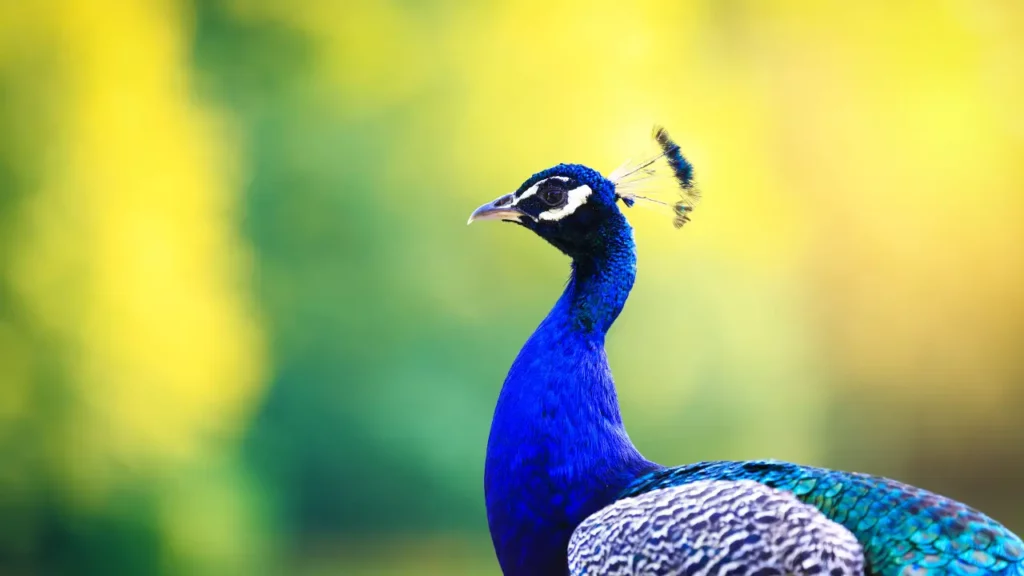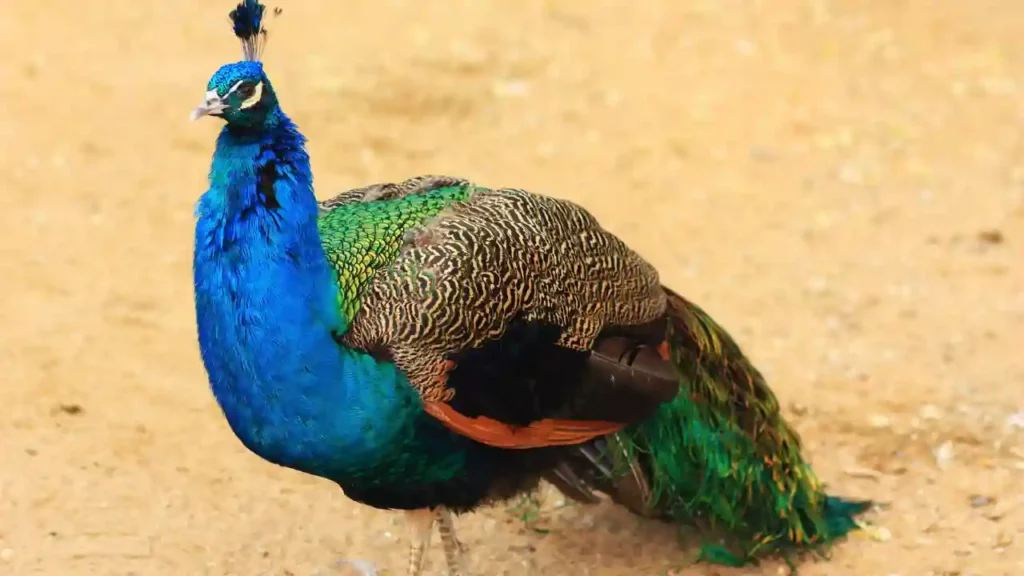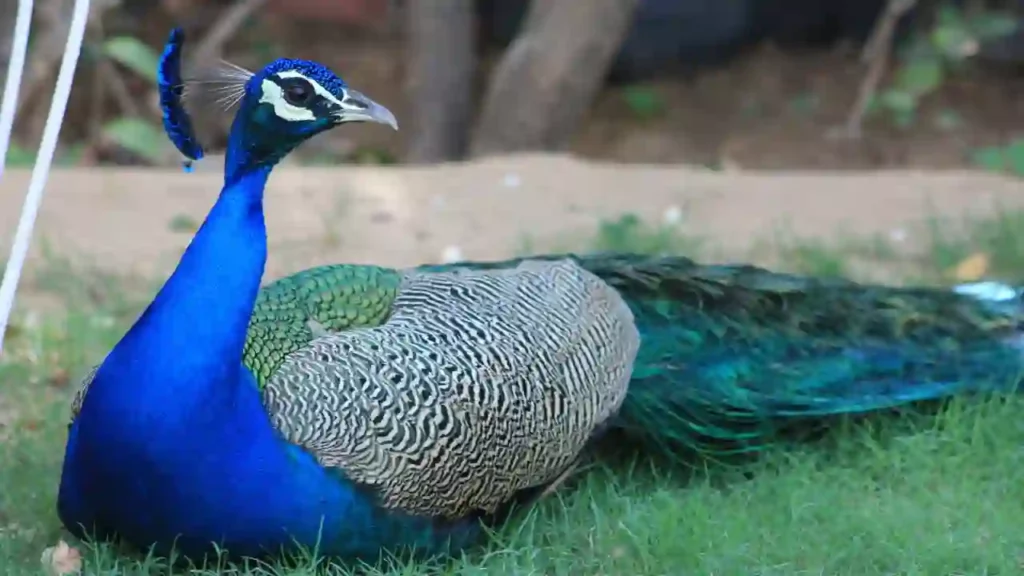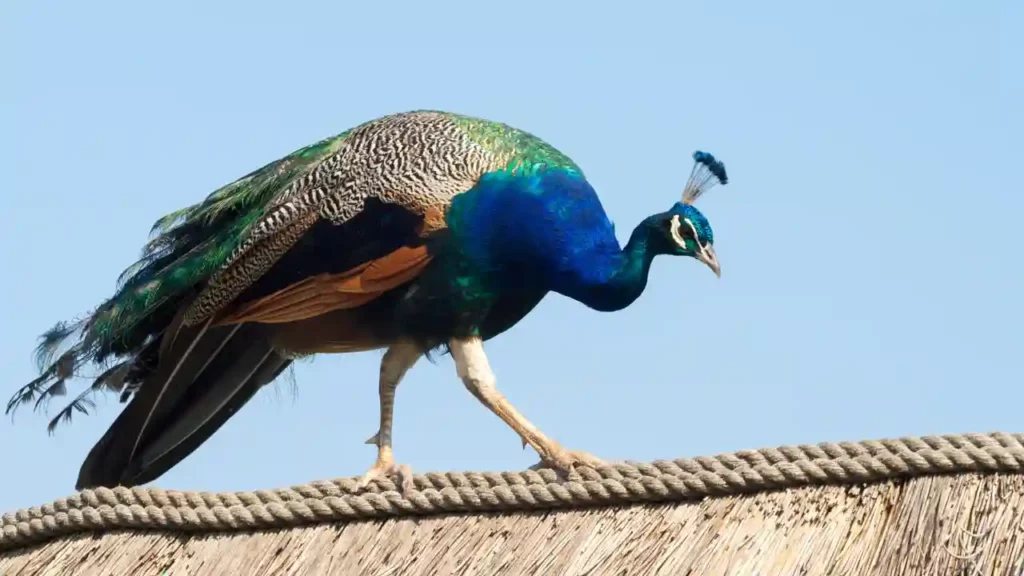Wondering about how long do peacocks live?
Peacocks typically have an average lifespan of 15-20 years, however they can live up to 40 years or more if provided with the right care. Wild peacocks tend to have shorter lifespans of around 5-10 years.
Let’s learn more about a peacock’s life cycle and know how long do peacocks live:
How Can You Tell How Old A Peacock Is?

Once a peacock reaches adulthood, it is impossible to determine its age, but you may determine it early in its life. Peacocks begin life as tiny chicks when they are newly hatched chicks.
One year old peafowl may be identified by sex, however both sexes will still primarily be brown in coloration.
Their eye spots and iridescent colors do not yet develop in them. Male peacocks get their distinctive color around the age of two.
They may weigh up to 15 pounds when they are completely mature.
Peahens gain glossy colorful feathers on their wings and throat and weigh around 10 pounds at around two years old.
Peacocks and peahens both become fully developed adults at three years old. They become fully grown and grow feathers all over their body by this age. When peacocks become three years old, it becomes quite challenging to determine their age, thereon.
What Is The Typical Lifespan Of A Peacock?
Peacocks have a lengthy lifespan, particularly when kept in captivity. Peacocks may survive up to 20 years if they receive the right care and eat a nutritious, healthy diet. They may remain alive up to 15 years in the wild, however it is difficult to determine the precise typical longevity.
Peacocks in captivity have significantly safer living conditions. They are safe from predators like jungle cats and have access to a steady source of wholesome food.
Food shortage is an issue in the forest environment because humans can cause habitats to become smaller, making it more difficult for animals to forage for food.
Now that they are a protected species, Indian peacock populations are booming.
The habitats of the Green peafowl and Congo peafowl, however, need to be protected more as they are categorized as vulnerable species.
How Long Do Peacocks Live In The Wild?

The exact lifespan of peacocks in the wild is unknown. It appears to be around 15 years on average; however, this can vary substantially.
There are several predators that peacocks must be on the lookout for, such as mongooses and jungle cats.
Although they try to live in packs and roost in trees, they are vulnerable to larger animals since they are unable to fly far or quickly.
Since becoming the national bird of India in 1963, the longevity of Indian peafowl is increasing. Peacocks are surviving longer now that hunting and eating them are forbidden.
How Long Do Peacocks Live In Captivity?
Peacocks may live up to a maximum of 20 years in captivity, which is a far longer lifespan than in the wild.
The absence of enemies and their regular food are credited as contributing to their extended lifetime in captivity.
Peacocks and peahens are becoming more popular among farmers because they are devoted birds that are effective at warning other animals of potential predators.
They may be quite a responsibility to take on, though, given how long they live.
If you are planning to raise them, make sure you have enough space for your peacock to live there for up to 20 years, and have a backup plan in place in case you must dispose of them at some point.
How Do Most Peacocks Die?
Disease, predators, hunting, shortage of food are the main causes peacocks die of.
The greatest number of peacocks die at the time of egg-laying due to egg binding. Egg binding is when the egg gets stuck in the womb and gets destroyed before coming out.
Very few chicks hatch out of eggs and thereafter also, survival is tough.
Diseases such as flu, mycoplasma, and endoparasites act as a major threat to the survival of newly-born chicks.
When the chicks grow into adults, they have to brave predators such as eagles and owls to continue to live.
What Is The Life Cycle Of A Peacock?
The life cycle of a peacock is rather simple.
The female deposits eggs, which eventually hatch into chicks, the chick acquires nutrition and develops into a juvenile bird, and ultimately an adult bird.
When a peacock has reached adulthood, the life cycle begins over with fresh eggs and young birds.
These Are The Stages Of Peacock Life Cycle:

Incubation
Peacocks lay 2 to 3 broods per season which they then incubate for a period of 28-30 days.
Peacocks’ eggs, when hatched, release chicks that resemble very much like the chicken, however, as they grow and they acquire the colorful feathers, their identity becomes distinct.
Independence
Peacocks learn to fly at the age of about 4 weeks. Though they pick up flying rather early, they do not leave the nest immediately.
After about 3 months, peacocks juvenile peacocks gain independence by foraging and hunting on their own.
Sexual Maturity
In a year, peacocks develop to almost their maximum size.
Peacocks at the age of two resemble mature adult males, although they lack the complete train and the recognisable “eyes” on the tail feathers.
Peacocks mature sexually approximately three years of age.
What Are The Predators Of Peacocks?
Predators that prey on peacocks often include tigers, leopards, civets, other wild cats, dogs, and mongooses.
For Indian peacocks, the train poses a serious concern since it occasionally prevents them from seeing potentially lethal predators approaching from behind.
The birds occasionally strike it fortunate when predators attempt to pull on their trains.
The peacocks are able to flee the situation right away since their feathers frequently just fall to the ground. Peahens are also preyed upon by these creatures, while peacocks are more at risk.
How Old Is The Oldest Peacock?
A lot of anecdotal evidence suggests that pet and captive peafowl may survive up to the age of 30 to 40 years. However,the oldest peacock hasn’t been proven with absolute certainty.
This sounds plausible considering that certain wild species can live up to 25 years old.
How Long Can Peacocks Live Without Food?
Peacocks in the wild constantly forage for survival, for Peacocks kept in captivity, they require to be fed at least twice daily.
As we know that peacocks are enormous birds with equally massive appetites, in order to maintain the health of their spectacular and colorful plumage though, the male peacock require a diet that is exceptionally high in protein.
To sustain and thrive optimally, peacocks need a diverse diet of leaves, vegetables, fruits, insects, grains and worms. In the absence of a wide source of protein and vitamins, peacocks perish soon.
Do Peacocks Survive Winter?
Peafowls are tropical birds that flourished in hot areas of India, Sri Lanka, and Africa. They can tolerate freezing temperatures but only to an extent, because of their acclimatization to warm settings.
Prolonged exposure to very low temperatures may be dangerous to the health and general longevity of these tropical birds but due to endurance and acclimatization, significant populations of these are found in Scotland and North America.
The farms and zoos in these nations house peacocks brought there earlier from countries such as India and Indonesia.
This is possible because Peafowls, like certain other birds, have a thermal storage mechanism in their feet that allows them to control the temperature of the body.
Additionally, Peafowls have spikes on their feet that assist them shield themselves from the snow and freezing temperatures.
They might not be substantial in really cold conditions, but they do assist. Feathers too provide great protection against low temperatures from late autumn through January.
Are Peacocks Protected?
The International Union for Conservation of Nature (IUCN) is a non-governmental organization based in the United Kingdom.
It classifies animals based on whether or not they are endangered. The Indian peafowl is not in risk of extinction.
They are, in reality, classified as Least Concern and are prospering in the wild. The Indian government is primarily responsible for their conservation status.
The Indian peafowl was designated as the country’s national bird in 1963. As a result, hunting or eating Indian peafowl is prohibited in India.
While Indian peafowl is not classified as “least concern”, other peafowl species such as The Green peafowl and the Africa-Congo peacock are endangered.
Certain nations make it lawful to possess a peacock. It is totally legal in Canada and the United States, for instance. Nevertheless, these peacocks must be classified as Indian peafowl. It is not possible to own endangered species.
Factors That Impact The Peacock Lifespan

Peacocks are under threat from habitat loss, smuggling, poaching, and predation. Populations of peacocks are falling.
The Congo peafowl is classified in the IUCN list as vulnerable species, whereas the Green peacock is endangered. Let’s look at some of the reasons responsible for the declining lifespan of peacocks:
Poaching:
One of the primary reasons peacock numbers have declined by even more than half is hunting and poaching for their feathers.
Peacock feathers can be utilised for various ornamental purposes.
Peacock meat is considered as exotic, as a result, live markets in East Asia drive the demand for illegal hunting and killing of peacocks.
Habitat loss:
Settlements, mining, wood harvesting, animal agriculture, egg collection, and hunting all contribute to the peacock population declining.
Peacocks, like many of the bird species, are facing habitat loss, which means less sources of food, shelter, and water and ultimately a threat to existence.
Commerce:
Pet commerce and animal entertainment industries also harm peacocks.
Peacocks are being preferred as pets in farms in America and Canada, however, being raised in captivity creates breeding restrictions and their populations are being limited.
Final Thoughts
Peacocks enjoy lengthy lifespan, although not as long as other exotic birds, which typically live for up to a century.
Peacocks may live as long as 20 years in the wild, but they are threatened by factors like habitat loss, predation, a shortage of food, poaching, and hunting.
With the right housing, warmth, and medical attention, peacocks may flourish and survive for up to 30 years or more in confinement.


